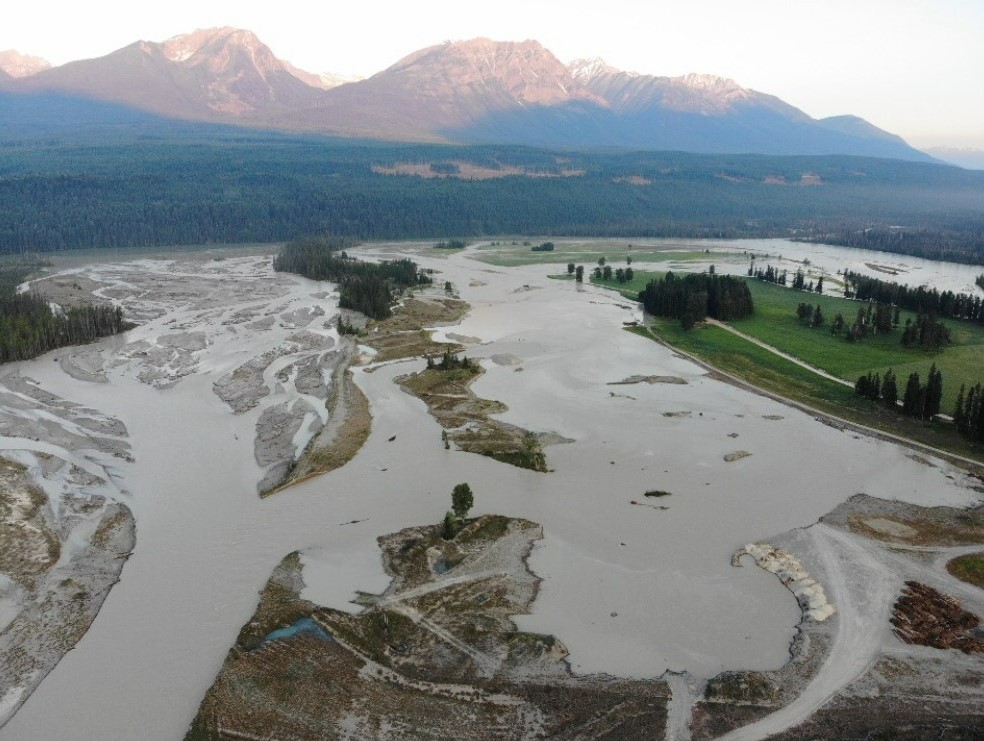Climate Change Impacts Local Conservation Efforts
The heat dome that settled over British Columbia last summer contributed to the devasting fires that swept through the province's interior, caused severe droughts in the Lower Mainland, and sent temperatures in some communities soaring.
It also impacted the Golden District Rod & Gun Club's Blaeberry River Confluence Restoration project in partnership with the BC Ministry of Forests, Lands, Natural Resource Operations and Rural Development.
The project received $500,000 from Healthy Watersheds Initiative to rehabilitate a former gravel-mining site where the Blaeberry River flows into the Columbia River, near Golden, BC, but club Executive Director Brian Gustafson says the heat dome’s effects forced the project team to reflect on other ways they could achieve their goals.
“It definitely changed the gears on what we wanted to accomplish,” he says.

The June 2021 heat caused abrupt spring flooding that washed away the dikes and gravel piles, restoring the region’s natural hydrology.
Photo - Claire Dibble
The Blaeberry River Confluence Restoration Project
Located within the Columbia Wetlands Wildlife Management Area and home to diverse wildlife, including several at-risk species, the area around the mouth of the Blaeberry River was once covered with dense vegetation. In particular, the area was known and named for its abundant berry bushes, which provided food for local First Nations, settlers, and wildlife.
But another valuable resource attracted the attention of industry. Gravel pit operators stripped the riverbanks, cleared the vegetation, and excavated the site. They built dikes to keep the river out of the areas where they were extracting gravel. That disrupted the river's natural flow and destabilized its banks. It also allowed invasive species to be introduced, which affected how the local ecosystem functioned.
When the BC Ministry of Forests, Lands, Natural Resource Operations and Rural Development approached the Golden District Rod and Gun Club in 2019 about rehabilitating the site, the goal was to restore the site’s natural hydrological and ecological processes to promote wildlife habitat recovery. The club hoped to clear out the remnants of the gravel pit, re-establish the original habitat by reintroducing native plants to the area, and construct a back-channel wetland to restore natural water flow.
The club is heavily invested in conservation activities, says Gustafson, who managed the Blaeberry River project.
“Knowing we are up here and that we have the capacity to manage these kinds of projects, we graciously accept them,” he says. “They are an opportunity for us to do positive conservation work in our own backyard.”
Nature Lends an Unexpected Hand
The June 2021 heat dome quickly melted the snowpack in the surrounding mountains and sent it rushing down local creeks and rivers. At the Blaeberry River site, the meltwater flood breached the dikes, changed the river's course, destabilized the banks, and submerged parts of the site.

The dikes and gravel pit at the Blaeberry River confluence site disrupted the river's natural flow and destabilized its banks.
Photo - Golden District Rod & Gun Club
The water also swept away tremendous amounts of abandoned gravel.
“The river moved about a million dollars of dirt for us,” Gustafson says, “and helped restore the natural hydrology of the region.”
The resulting cost savings allowed the club to achieve a higher level of reclamation in less area. Once the high water passed, the team integrated a substantial amount of rock into the riverbanks to restabilize them and prevent future erosion. They also created a wetland in the former gravel pit and planted the site with native trees and shrubs, working with the local Akisqunuk and Secwepemc First Nations to select species based on traditional knowledge.
“It went from a plain landscape with nothing but gravel to a site with character and diversity,” Gustafson says.

Work done to stabilize the riverbank will help the area better withstand spring flooding in the future.
Photo - Golden District Rod & Gun Club
When the project is finished in 2022, the BC Ministry of Forests, Lands, Natural Resource Operations and Rural Development will continue to manage the site as part of the Columbia Wetlands Wildlife Management Area. Interpretative signs will share the area's Indigenous history and detail how traditional knowledge informed the site’s restoration.
The project provided employment for regionally based aquatic ecologists and members of the Akisqnuk First Nations, as well as a photographer, project manager, and equipment operators and labourers from the area. Outdoor education students from the local high school helped plant willows and cottonwoods during a site visit to learn about ecosystems and habitat restoration.
Climate Change–related Lessons
The Blaeberry River project may have benefitted from June’s heat dome in BC, but climate change is creating problems for many other Golden District Rod and Gun Club conservation projects.
As a result, Gustafson says the club is changing how it approaches conservation projects. Projects will no longer be completed with a status quo bias. Instead, the team is beginning to develop contingency plans, including adjusting timeframes and project expectations, as well as analyzing how climate events can be used as a guiding hand or indicator of a region’s pre-developed or natural state.
As for the club itself? Its members view efforts like the Blaeberry River restoration as increasingly vital as climate change impacts more and more Canadians and more and more wildlife habitats.

Outdoor education students form the local high school class tour the site.
Photo - Ron Ainslie
Learn about other HWI-funded community projects preparing for climate change.
Written by Miranda Stahn - a freelance writer and science communicator who is passionate about promoting clean-tech solutions to mitigate climate change.







